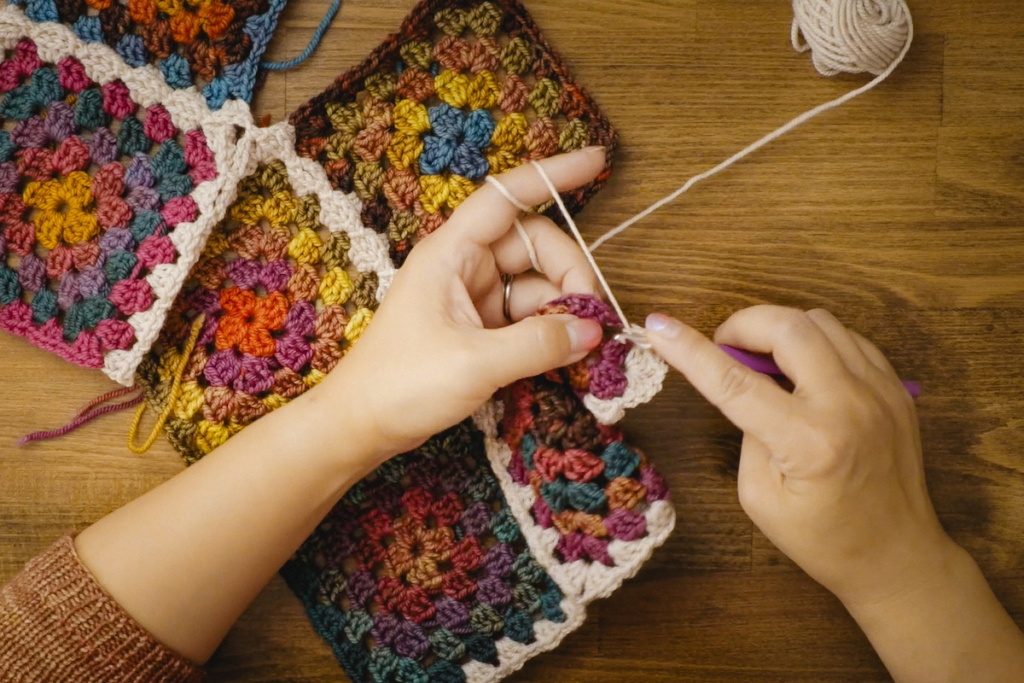
how to join anonymous
Granny squares are timeless building blocks in the world of crochet, beloved for their versatility, color possibilities, and nostalgic charm. Whether you’re crafting a cozy blanket, a stylish bag, or a boho-chic garment, knowing how to join granny squares the right way is key to transforming small motifs into stunning, cohesive projects. how to join anonymous
In this comprehensive guide, we’ll explore various techniques for joining granny squares, each offering unique textures and finishes. From beginner-friendly stitches to more decorative methods, you’ll learn everything you need to confidently connect your squares with professional finesse. So grab your hook and let’s stitch it all together! how to join anonymous
Understanding Granny Squares

Granny squares are small, square-shaped crochet motifs that can be used individually or combined to create larger pieces. Typically worked in the round, they offer a fantastic canvas for experimenting with colors and stitch variations. The classic granny square features groups of double crochets separated by chain spaces, but variations like solid granny squares or circular centers offer creative flexibility. how to join anonymous
Before you dive into joining, it’s crucial to ensure your granny squares are uniform in size and shape. This is where blocking comes in. Blocking is the process of shaping your squares with moisture and pinning them to dry in the correct dimensions. Even tension and consistent stitch counts also play a huge role in the success of your final project. It might seem like an extra step, but properly prepped squares are the foundation of a polished look.
Another important factor is yarn type and hook size. Ensure you’re using the same weight and fiber throughout your squares and when joining. This consistency helps prevent puckering or uneven seams. Ultimately, understanding the anatomy of granny squares gives you more control and confidence as you approach the joining phase of your crochet journey. how to join anonymous
Tools and Materials You’ll Need
While granny squares themselves require minimal supplies, having the right tools for joining them makes the process smoother and more enjoyable. First and foremost, you’ll need a reliable crochet hook. It’s usually best to use the same hook size you used for your squares, though going up or down a size can help achieve a tighter or looser join depending on your project’s needs. how to join anonymous
Yarn selection is equally critical. If you want your joins to be invisible, choose the same color and weight as your squares. On the other hand, a contrasting yarn can add a design element, turning your joins into a decorative feature. Cotton yarns offer great stitch definition and are ideal for flat seams, while acrylic yarns are stretchy and forgiving, great for cozy blankets.
Don’t forget a tapestry needle for sewing-based joins like the whip stitch, and keep scissors handy for trimming ends. Stitch markers can also be useful for lining up corners or marking progress on large projects. A measuring tape helps ensure uniformity as you go, especially in blankets or garments where size accuracy matters. how to join anonymous
Equipping yourself with these tools ahead of time allows for a smoother process and more enjoyable experience. Plus, investing in quality tools ensures your work not only looks good but lasts for years to come. how to join anonymous
Popular Methods to Join Granny Squares
Slip Stitch Join
The slip stitch join is one of the easiest and cleanest ways to join granny squares. Using your crochet hook, you simply work through the outer loops of two squares and connect them using slip stitches. This method produces a nearly invisible seam when worked from the back and creates a subtle ridge when done from the front — which some crocheters use as a design detail.
What makes the slip stitch method appealing is its simplicity. You don’t need extra tools beyond your hook, and it works up quickly once you get the hang of it. However, it can be a bit tight and may pull the squares slightly if your tension is too firm. Always check your gauge and adjust your grip to maintain flexibility in the join.
Single Crochet Join
If you prefer a more textured look, the single crochet join might be your go-to. Like the slip stitch method, this technique also involves connecting squares edge-to-edge, but with single crochet stitches. The result is a more defined, raised ridge that gives structure to your project and highlights each square. how to join anonymous
This join is excellent for afghans and cushions where you want each motif to stand out. To achieve a clean finish, work through the back loops or outer loops only. Be consistent and count stitches to ensure alignment across each row of squares. how to join anonymous
Whip Stitch Join (Sewing Method)
For those who prefer sewing over hooking, the whip stitch is a classic go-to. Using a tapestry needle and yarn, you sew the squares together by passing the needle through the edge stitches of adjacent squares in a spiral motion. This method is nearly invisible when done with matching yarn and works particularly well for lightweight or lacy granny squares. how to join anonymous
The whip stitch offers excellent flexibility and is great for portable projects. However, it can be time-consuming for larger items and may require more frequent tightening of stitches to avoid gaps. Still, it’s a favorite among traditional crocheters for its polished, hand-crafted look. how to join anonymous
Join-As-You-Go (JAYGO)
This method is a game-changer for large-scale projects. As the name suggests, the join-as-you-go method allows you to connect each new square to the previous ones during the final round of the motif. It eliminates the need for sewing or separate joining steps, making the process faster and more efficient.
JAYGO requires a bit of planning, especially for color placement and layout, but it results in a seamless and flexible fabric. It’s ideal for blankets, shawls, and garments where mobility and drape are important. It’s also great for visual learners, as you see your project grow square by square.
Flat Braid Join
Looking for something decorative? The flat braid join uses chain spaces and picots to connect your squares with a lacy, openwork design. It’s visually striking and adds a handmade, vintage feel to your work. While this method is more time-intensive, it’s worth it for heirloom-quality projects or when you want a border that becomes part of the design. how to join anonymous
Tips for a Professional Finish
Mastering how to join granny squares is just the start — polishing your project takes a few expert tips. Always ensure that your tension is consistent across all joins. Uneven joins can create ripples or tighten the fabric in places, distorting your final product.
Blocking your squares before joining ensures they are uniform in size, making alignment easier. After joining, a second round of blocking can help the seams settle and improve the overall drape.
When it comes to color, consider whether you want the joins to blend in or stand out. A contrasting color can create a stained-glass effect, while matching yarn makes the squares flow together seamlessly. Lastly, always weave in ends neatly and securely. A good finish is what separates a handmade treasure from a rushed project.
Adding a border around the entire piece once all squares are joined can unify the design and hide any small imperfections. Choose a border that complements the join method — something simple for intricate joins and vice versa. how to join anonymous
Conclusion
Learning how to join granny squares is a vital step in turning your creative ideas into real-life crochet projects. With a variety of methods at your disposal — from classic sewing techniques to modern join-as-you-go styles — you have the flexibility to tailor your joins to suit your design and skill level. The key is preparation, consistency, and a willingness to try new techniques. So, go ahead and turn those charming little squares into something beautiful and lasting! how to join anonymous
FAQs
What is the easiest method to join granny squares for beginners?
The slip stitch or whip stitch methods are generally the easiest for beginners due to their simplicity and minimal tools required. how to join anonymous
Can I mix different joining methods in one project?
Yes, you can mix methods for creative effect, though it’s best to keep consistency within sections to maintain a cohesive look.
Do I need to block granny squares before joining?
Blocking helps ensure uniformity and better alignment, especially for larger or intricate projects.
What’s the best method for joining squares in a large blanket?
Join-as-you-go (JAYGO) is great for large projects, offering seamless joins and faster assembly.
How do I keep my seams from looking bulky?
Use flat joining methods like the whip stitch or slip stitch through outer loops to keep seams minimal.
Is there a no-sew way to join granny squares?
Yes, JAYGO and crochet-based joins like slip stitch or single crochet are great no-sew options.
How do I add a border after joining the squares?
Once all squares are joined, crochet a border around the outer edge using simple stitches like single crochet, half-double, or decorative picots. how to join anonymous






